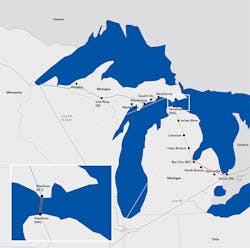Army Corps extends review of Enbridge pipeline tunnel plan for Great Lakes
The environmental review of the Enbridge Inc. plan for a Line 5 pipeline tunnel under the Straits of Mackinac will take much longer than planned, until spring 2025 according to the US Army Corps of Engineers.
The Corps, responsible for Clean Water Act permitting of construction projects, came up with a timeline that envisioned a proposed environmental impact statement (EIS) being issued in late 2023. Now the proposed EIS will take as much as a year and a half longer under the revised schedule.
The added time by the corps moves release of the proposed EIS from a year before the 2024 presidential election to several months after the election.
Enbridge expressed disappointment with the extended timeline. “The Great Lakes Tunnel Project covers only approximately four miles in length, will require no construction within the waters of the straits, and is anticipated to impact less than one-quarter acre of wetlands,” a company statement said.
Enbridge submitted its application for the project to the Corps of Engineers in April 2020. Now it appears the corps will take 6 years to review the project and issue a decision, Enbridge said.
In the past, the company has said construction of the tunnel project would take about 4 years. Under the new timeline, that would mean completion in 2030.
Reform plan
The delay was announced in a week during which Congress has engaged in much back-and-forth discussion over permitting reform.
In the House, Republicans are assembling an array of energy reform ideas in a bill designated the Lower Energy Costs Act (H.R. 1), intended to overhaul energy and infrastructure permitting. It is pulling together a large number of provisions developed through the Energy and Commerce Committee, the Transportation and Infrastructure Committee, and the Natural Resources Committee.
H.R. 1 may get through the House with few or no Democratic votes and then be halted by the Senate’s Democratic majority. But given the persistence of permitting delays under the National Environmental Policy Act and in federal courts, the issue will not go away.
One for two split
Enbridge has operated Line 5 in Michigan for about 70 years with a crossing that sits on the bed of the straits, not beneath the bed. The crossing has never had a leak, according to Enbridge.
The 30-in. OD pipeline runs through the Upper Peninsula and Lower Peninsula of Michigan, but splits into two 20-in. OD pipes for the 4.5-mile crossing between the peninsulas.
The tunnel plan would bore through rock beneath the bed and build a single 30-in. OD line through the tunnel.
Line 5 has the capacity to carry up to 540,000 b/d of crude oil and propane. The line serves 10 refineries to varying degrees, in Michigan, Ohio, Pennsylvania, Ontario, and Quebec, according to the operator.
